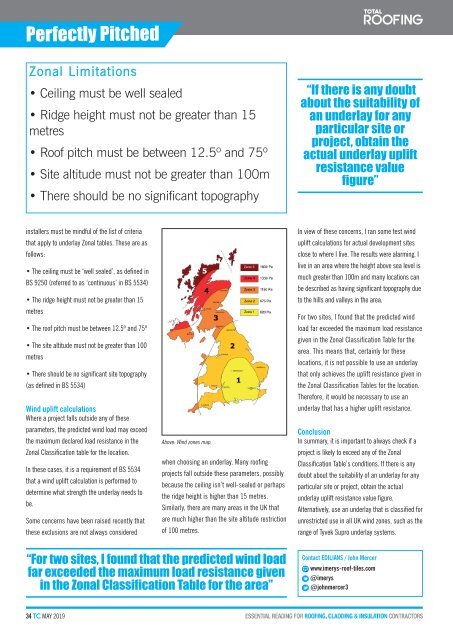May 2019
You also want an ePaper? Increase the reach of your titles
YUMPU automatically turns print PDFs into web optimized ePapers that Google loves.
Perfectly Pitched<br />
Zonal Limitations<br />
• Ceiling must be well sealed<br />
• Ridge height must not be greater than 15<br />
metres<br />
• Roof pitch must be between 12.5º and 75º<br />
• Site altitude must not be greater than 100m<br />
• There should be no significant topography<br />
“If there is any doubt<br />
about the suitability of<br />
an underlay for any<br />
particular site or<br />
project, obtain the<br />
actual underlay uplift<br />
resistance value<br />
figure”<br />
installers must be mindful of the list of criteria<br />
that apply to underlay Zonal tables. These are as<br />
follows:<br />
• The ceiling must be ‘well sealed’, as defined in<br />
BS 9250 (referred to as ‘continuous’ in BS 5534)<br />
• The ridge height must not be greater than 15<br />
metres<br />
• The roof pitch must be between 12.5º and 75º<br />
• The site altitude must not be greater than 100<br />
metres<br />
• There should be no significant site topography<br />
(as defined in BS 5534)<br />
Wind uplift calculations<br />
Where a project falls outside any of these<br />
parameters, the predicted wind load may exceed<br />
the maximum declared load resistance in the<br />
Zonal Classification table for the location.<br />
In these cases, it is a requirement of BS 5534<br />
that a wind uplift calculation is performed to<br />
determine what strength the underlay needs to<br />
be.<br />
Some concerns have been raised recently that<br />
these exclusions are not always considered<br />
Above: Wind zones map.<br />
when choosing an underlay. Many roofing<br />
projects fall outside these parameters, possibly<br />
because the ceiling isn’t well-sealed or perhaps<br />
the ridge height is higher than 15 metres.<br />
Similarly, there are many areas in the UK that<br />
are much higher than the site altitude restriction<br />
of 100 metres.<br />
In view of these concerns, I ran some test wind<br />
uplift calculations for actual development sites<br />
close to where I live. The results were alarming. I<br />
live in an area where the height above sea level is<br />
much greater than 100m and many locations can<br />
be described as having significant topography due<br />
to the hills and valleys in the area.<br />
For two sites, I found that the predicted wind<br />
load far exceeded the maximum load resistance<br />
given in the Zonal Classification Table for the<br />
area. This means that, certainly for these<br />
locations, it is not possible to use an underlay<br />
that only achieves the uplift resistance given in<br />
the Zonal Classification Tables for the location.<br />
Therefore, it would be necessary to use an<br />
underlay that has a higher uplift resistance.<br />
Conclusion<br />
In summary, it is important to always check if a<br />
project is likely to exceed any of the Zonal<br />
Classification Table’s conditions. If there is any<br />
doubt about the suitability of an underlay for any<br />
particular site or project, obtain the actual<br />
underlay uplift resistance value figure.<br />
Alternatively, use an underlay that is classified for<br />
unrestricted use in all UK wind zones, such as the<br />
range of Tyvek Supro underlay systems.<br />
“For two sites, I found that the predicted wind load<br />
far exceeded the maximum load resistance given<br />
in the Zonal Classification Table for the area”<br />
Contact EDILIANS / John Mercer<br />
www.imerys-roof-tiles.com<br />
@imerys<br />
@johnmercer3<br />
34 TC MAY <strong>2019</strong>

















